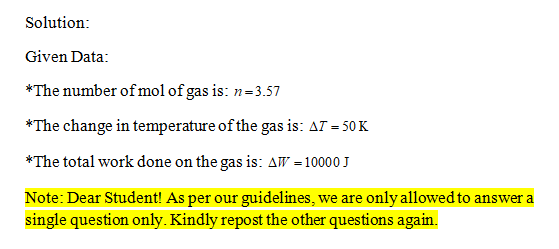's claim? ng point. N An ideal gas is confined to a cylindrical container with a movable piston on one end. The 3.57 mol of gas undergo: temperature change from 300.0 K to 350.0 K. If the total work done on the gas during this process is 1.00 x 104 J, what is the energy transferred as heat during this process? Is the heat flow into or out of the system?
's claim? ng point. N An ideal gas is confined to a cylindrical container with a movable piston on one end. The 3.57 mol of gas undergo: temperature change from 300.0 K to 350.0 K. If the total work done on the gas during this process is 1.00 x 104 J, what is the energy transferred as heat during this process? Is the heat flow into or out of the system?
Elements Of Electromagnetics
7th Edition
ISBN:9780190698614
Author:Sadiku, Matthew N. O.
Publisher:Sadiku, Matthew N. O.
ChapterMA: Math Assessment
Section: Chapter Questions
Problem 1.1MA
Related questions
Question

Transcribed Image Text:boiling point.
nufacturer's claim?
temperature change from 300.0 K to 350.0 K. If the total work
done on the gas during this process is 1.00 × 104 J, what is the
energy transferred as heat during this process? Is the heat flow
23. N An ideal gas is confined to a cylindrical container with a
2ovable piston on one end. The 3.57 mol of gas undergo a
done on the gas during this
process is 1.00 × 104 J, what is the
into or out of the system?

Transcribed Image Text:26. NA 25-g ice cube at 0.0°C is heated. After it first melts, the
lemperature increases to the boiling point of water (100.0°C).
and the water then boils to form 25 g of water vapor at 100.0 C.
How much energy in total is added to the ice/water? Which
Process (melting, increasing temperature, or boiling) requires
e most energy? Water has a latent heat of vaporization of
specific heat of 4190 J/(kg · K).
fon
ice cube of mass
Expert Solution
Step 1

Step by step
Solved in 3 steps with 3 images

Knowledge Booster
Learn more about
Need a deep-dive on the concept behind this application? Look no further. Learn more about this topic, mechanical-engineering and related others by exploring similar questions and additional content below.Recommended textbooks for you

Elements Of Electromagnetics
Mechanical Engineering
ISBN:
9780190698614
Author:
Sadiku, Matthew N. O.
Publisher:
Oxford University Press

Mechanics of Materials (10th Edition)
Mechanical Engineering
ISBN:
9780134319650
Author:
Russell C. Hibbeler
Publisher:
PEARSON

Thermodynamics: An Engineering Approach
Mechanical Engineering
ISBN:
9781259822674
Author:
Yunus A. Cengel Dr., Michael A. Boles
Publisher:
McGraw-Hill Education

Elements Of Electromagnetics
Mechanical Engineering
ISBN:
9780190698614
Author:
Sadiku, Matthew N. O.
Publisher:
Oxford University Press

Mechanics of Materials (10th Edition)
Mechanical Engineering
ISBN:
9780134319650
Author:
Russell C. Hibbeler
Publisher:
PEARSON

Thermodynamics: An Engineering Approach
Mechanical Engineering
ISBN:
9781259822674
Author:
Yunus A. Cengel Dr., Michael A. Boles
Publisher:
McGraw-Hill Education

Control Systems Engineering
Mechanical Engineering
ISBN:
9781118170519
Author:
Norman S. Nise
Publisher:
WILEY

Mechanics of Materials (MindTap Course List)
Mechanical Engineering
ISBN:
9781337093347
Author:
Barry J. Goodno, James M. Gere
Publisher:
Cengage Learning

Engineering Mechanics: Statics
Mechanical Engineering
ISBN:
9781118807330
Author:
James L. Meriam, L. G. Kraige, J. N. Bolton
Publisher:
WILEY